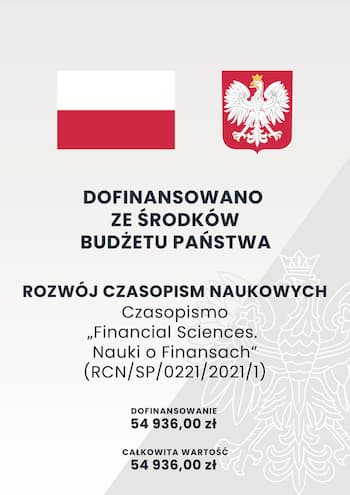Issues
Click a year to expand it.
40 Points
on Ministry of Education and Science journal evaluation list of 2024

Search results for query: Zaremba
Sort by: Relevance Author: Ascending Descending Year: Ascending Descending
- Strong ESG risk management as a way to improve organisational resilience in times of crisis: an analysis of WIG-ESG index constituents
Author: Ulyana Zaremba
See Issue Contents: fins.2023.1
Abstract:During the last decade sustainable investment practices have evolved substantially. ESG reporting is moving seamlessly from voluntary to mandatory. By investing in companies that score high in ESG rankings, investors hope for the organisation's resilience to the crisis and higher returns. Due to the dynamic development of socially responsible investing both in Poland and worldwide, new indices using ESG screening criteria are being designed, which in turn are the underlying instrument for structured products. The aim of the study was to analyse the constituents of the newly created WIG-ESG index and to discuss its performance and organisational resilience in relation to ESG risk exposure and management. The research showed that the criteria for inclusion in the WIG-ESG index should be amended to recognise companies that care about strong ESG risk management and exclude those with negligible ESG efforts. The second important issue is eligibility for inclusion. If all companies are eligible to be included in the index (ESG testing as a condition for inclusion), this will reduce the rotation of the index's constituents and allow the relationship between a company's ESG score after each update and its long-term performance to be explored.
- Comparison of Crypto-Assets Market Risk Proxies
Author: Aleksander Mercik, Daniel Cupriak
See Issue Contents: fins.2021.1
Abstract:In early 2021, the cryptoasset market capitalization exceeded $1.5 trillion, and there were more than 300 exchanges in the world where over 8,000 tokens could be traded. As part of research related to mature segments of the financial market (e.g. the stock market in the United States), scientists and practitioners have been trying to identify key risk factors for several decades, thanks to which it is possible to explain the equity risk premium for an investment in a given asset class. In recent years, there have been an increasing number of researchers trying to identify these factors for cryptoassets. The aim of this article was to analyse popular cryptoasset indices in order to identify those that can be used as a proxy of the market portfolio in order to estimate this risk factor premium. The research results indicate that the market risk factor is an important element of the market under study, and the indices that best reflect it are an index consisting of all cryptoassets weighted by capitalization and Coin100 which contains only the 100 largest cryptoassets.
- Explanatory Theories of Stock Returns in the Long Run After IPO – Literature Review
Author: Martyna Żyła
See Issue Contents: fins.2022.2
Abstract:Negative returns of shares in the long run after initial public offerings have been confirmed on many markets however, the explanation for the cause of this phenomenon is ambiguous. Investigating underperformance is important because it allows a better understanding of the role of the stock markets in the financial system. Such market anomaly influence the behaviour of investors in the long run. Underperformance is featured in an extensive body of empirical literature and has been confirmed in most cases. However, it is inconclusive what affects such phenomenon on the markets. The purpose of this paper is to present the explanatory theories which are based on the behaviour of market participants and to summarize the explanatory variables of underperformance that stem from the theory.
- The social impact bond as a financial instrument
Author: Marcin Wiśniewski
See Issue Contents: fins.2018.4
Abstract:Social impact bonds are an innovative mechanism for financing social tasks with the financial resources of private investors. The repayment of the capital invested and capital gains depends on obtaining a predetermined social aim that is paid for by the public side under the “payment for results” formula. The previous work on this mechanism focused mainly on its task and organizational dimension. In this paper, the author attempts to define the social impact bond as a financial instrument. In particular, the financial side of the mechanism is considered. First, an attempt is made to determine the place of the social impact bond in the theoretical classifications of financial instruments. Second, the place of the instrument is indicated in the system of financial law. Finally, some remarks are made on the need to have the new instrument regulated in Polish legislation






